7
Monitoring and Controlling Process Group
The processes in the Monitoring and Controlling Process Group are shown in Table 7-1.
Table 7-1. Monitoring and Controlling Process Group Processes

The Monitoring and Controlling Process Group consists of those processes required to track, review, and regulate the progress and performance of the project; identify any areas in which changes to the plan are required; and initiate the corresponding changes. Monitoring is collecting project performance data, producing performance measures, and reporting and disseminating performance information. Controlling is comparing actual performance with planned performance, analyzing variances, assessing trends to effect process improvements, evaluating possible alternatives, and recommending appropriate corrective action as needed.
The key benefit of this Process Group is that project performance is measured and analyzed at regular intervals, appropriate events, or when exception conditions occur in order to identify and correct variances from the project management plan. The Monitoring and Controlling Process Group also involves the following activities:
▶Evaluate change requests and decide on the appropriate response.
▶Recommend corrective or preventive action in anticipation of possible problems.
▶Monitor the ongoing project activities against the project management plan and project baselines.
▶Influence the factors that could circumvent the change control process so only approved changes are implemented.
Continuous monitoring provides the project team and other stakeholders with insight into the status of the project and identifies any areas that require additional attention. The Monitoring and Controlling Process Group monitors and controls the work being done within each Process Group, each life cycle phase, and the project as a whole. The Monitoring and Controlling Process Group includes the project management processes identified in Sections 7.1 through 7.12.
7.1 MONITOR AND CONTROL PROJECT WORK
Monitor and Control Project Work is the process of tracking, reviewing, and reporting the overall progress to meet the performance objectives defined in the project management plan. The key benefits of this process are that it allows stakeholders to understand the current state of the project, to recognize the actions taken to address any performance issues, and to have visibility into the future project status with cost and schedule forecasts.
This process is performed throughout the project. The inputs, tools and techniques, and outputs are shown in Figure 7-1. Figure 7-2 presents the data flow diagram for this process.

Note: This figure provides the inputs, tools and techniques, and outputs that may be used for this process. Descriptions for inputs and outputs appear in Section 9. Descriptions for tools and techniques appear in Section 10.
Figure 7-1. Monitor and Control Project Work: Inputs, Tools & Techniques, and Outputs
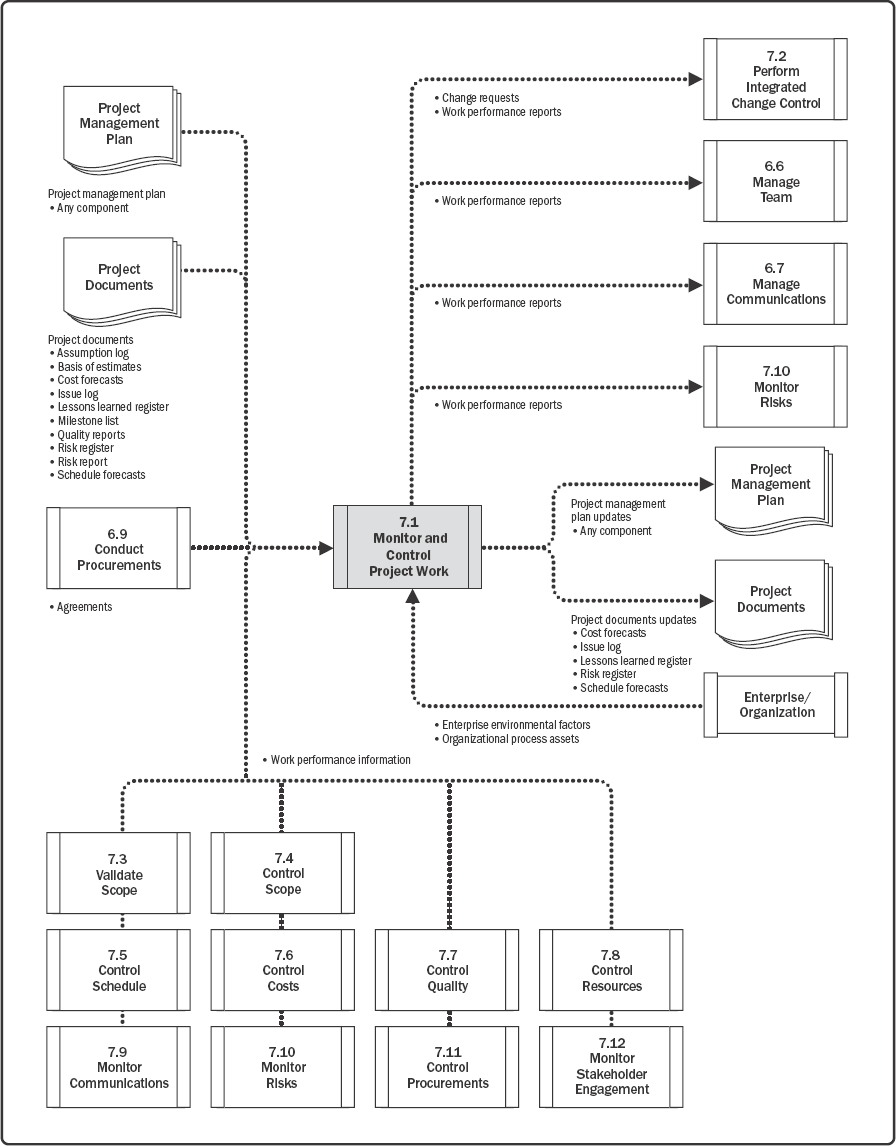
Figure 7-2. Monitor and Control Project Work: Data Flow Diagram
Note: This figure provides the inputs and outputs that may be used for this process. Descriptions for inputs and outputs appear in Section 9.
Monitoring is an aspect of project management performed throughout the project. Monitoring includes collecting, measuring, and assessing measurements and trends to effect process improvements. Continuous monitoring gives the project management team insight into the health of the project and identifies any areas that may require special attention. Control includes determining corrective or preventive actions or replanning and following up on action plans to determine whether the actions taken resolved the performance issue. The Monitor and Control Project Work process is concerned with:
▶Comparing actual project performance against the project management plan;
▶Assessing performance periodically to determine whether any corrective or preventive actions are indicated, and then recommending those actions as necessary;
▶Checking the status of individual project risks;
▶Maintaining an accurate, timely information base concerning the project's product(s) and their associated documentation through project completion;
▶Providing information to support status reporting, progress measurement, and forecasting;
▶Providing forecasts to update current cost and current schedule information;
▶Monitoring implementation of approved changes as they occur;
▶Providing appropriate reporting on project progress and status to program management when the project is part of an overall program; and
▶Ensuring that the project stays aligned with the business needs.
7.2 PERFORM INTEGRATED CHANGE CONTROL
Perform Integrated Change Control is the process of reviewing all change requests; approving changes and managing changes to deliverables, project documents, and the project management plan; and communicating the decisions. This process reviews all requests for changes to project documents, deliverables, or the project management plan and determines the resolution of the change requests. The key benefit of this process is that it allows for documented changes within the project to be considered in an integrated manner while addressing overall project risk, which often arises from changes made without consideration of the overall project objectives or plans.
This process is performed throughout the project. The inputs, tools and techniques, and outputs are shown in Figure 7-3. Figure 7-4 presents the data flow diagram for this process.

Note: This figure provides the inputs, tools and techniques, and outputs that may be used for this process. Descriptions for inputs and outputs appear in Section 9. Descriptions for tools and techniques appear in Section 10.
Figure 7-3. Perform Integrated Change Control: Inputs, Tools & Techniques, and Outputs
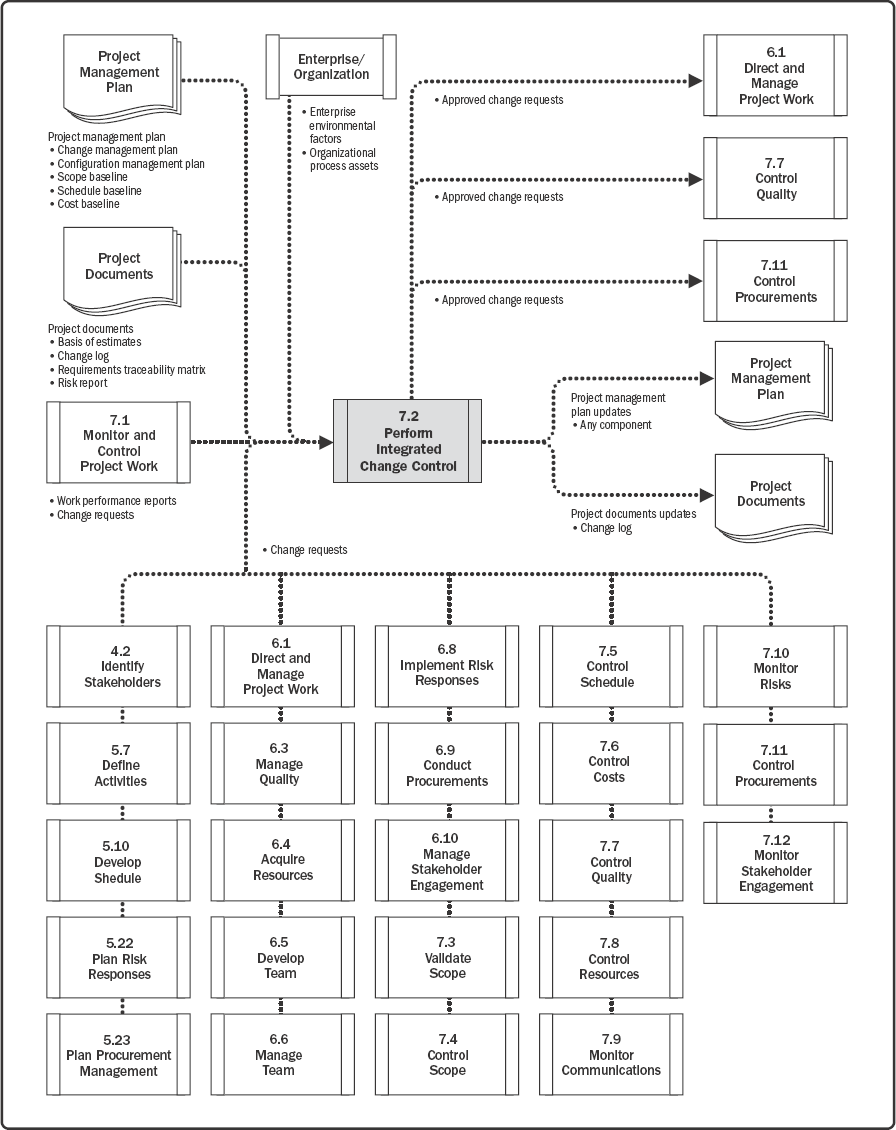
Note: This figure provides the inputs and outputs that may be used for this process. Descriptions for inputs and outputs appear in Section 9.
Figure 7-4. Perform Integrated Change Control: Data Flow Diagram
The Perform Integrated Change Control process is conducted from project start through completion and is the ultimate responsibility of the project manager. Change requests can impact the project scope and the product scope, as well as any project management plan component or any project document. Changes may be requested by any stakeholder involved with the project and may occur at any time throughout the project life cycle. The applied level of change control is dependent upon the application area, complexity of the specific project, contract requirements, and the context and environment in which the project is performed.
Before the baselines are established, changes are not required to be formally controlled by the Perform Integrated Change Control process. Once the project is baselined, change requests go through this process. As a general rule, each project's configuration management plan should define which project artifacts need to be placed under configuration control. Any change in a configuration element should be formally controlled and will require a change request.
Although changes may be initiated verbally, they should be recorded in written form and entered into the change management and/or configuration management system. Change requests may require information on estimated schedule impacts and estimated cost impacts prior to approval. Whenever a change request may impact any of the project baselines, a formal integrated change control process is always required. Every documented change request needs to be either approved, deferred, or rejected by a responsible individual, usually the project sponsor or project manager. The responsible individual will be identified in the project management plan or by organizational procedures. When required, the Perform Integrated Change Control process includes a change control board (CCB), which is a formally chartered group responsible for reviewing, evaluating, approving, deferring, or rejecting changes to the project and for recording and communicating such decisions.
Approved change requests can require new or revised cost estimates, activity sequences, schedule dates, resource requirements, and/or analysis of risk response alternatives. These changes can require adjustments to the project management plan and other project documents. Customer or sponsor approval may be required for certain change requests after CCB approval, unless they are part of the CCB.
7.3 VALIDATE SCOPE
Validate Scope is the process of formalizing acceptance of the completed project deliverables. The key benefit of this process is that it brings objectivity to the acceptance process and increases the probability of final product, service, or result acceptance by validating each deliverable.
This process is performed periodically throughout the project as needed. The inputs, tools and techniques, and outputs are shown in Figure 7-5. Figure 7-6 presents the data flow diagram for this process.
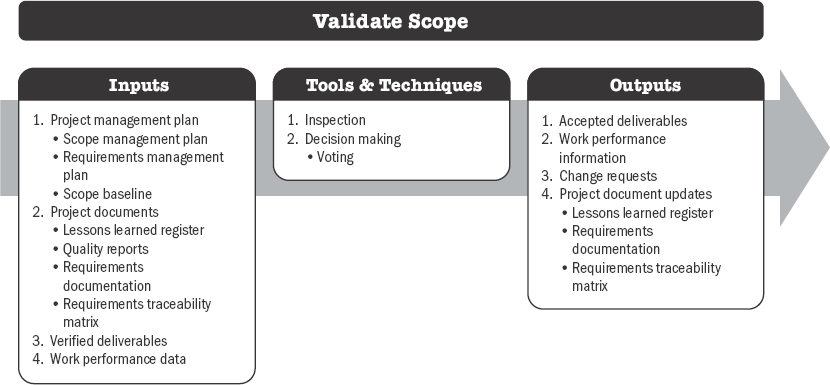
Note: This figure provides the inputs, tools and techniques, and outputs that may be used for this process. Descriptions for inputs and outputs appear in Section 9. Descriptions for tools and techniques appear in Section 10.
Figure 7-5. Validate Scope: Inputs, Tools & Techniques, and Outputs

Note: This figure provides the inputs and outputs that may be used for this process. Descriptions for inputs and outputs appear in Section 9.
Figure 7-6. Validate Scope: Data Flow Diagram
The verified deliverables obtained from the Control Quality process are reviewed with the customer or sponsor to ensure they are completed satisfactorily and have received formal acceptance of the deliverables by the customer or sponsor. In this process, the outputs obtained as a result of the Planning processes for scope, such as the requirements documentation or the scope baseline, as well as the work performance data obtained from the Executing processes, are the basis for performing the validation and for final acceptance.
The Validate Scope process is primarily concerned with acceptance of the deliverables while the Control Quality process is primarily concerned with correctness of the deliverables and meeting the quality requirements specified for the deliverables. Control Quality is generally performed before Validate Scope, although the two processes may be performed in parallel.
7.4 CONTROL SCOPE
Control Scope is the process of monitoring the status of the project and product scope and managing changes to the scope baseline. The key benefit of this process is that the scope baseline is maintained throughout the project.
This process is performed throughout the project. The inputs, tools and techniques, and outputs are shown in Figure 7-7. Figure 7-8 presents the data flow diagram for this process.

Note: This figure provides the inputs, tools and techniques, and outputs that may be used for this process. Descriptions for inputs and outputs appear in Section 9. Descriptions for tools and techniques appear in Section 10.
Figure 7-7. Control Scope: Inputs, Tools & Techniques, and Outputs
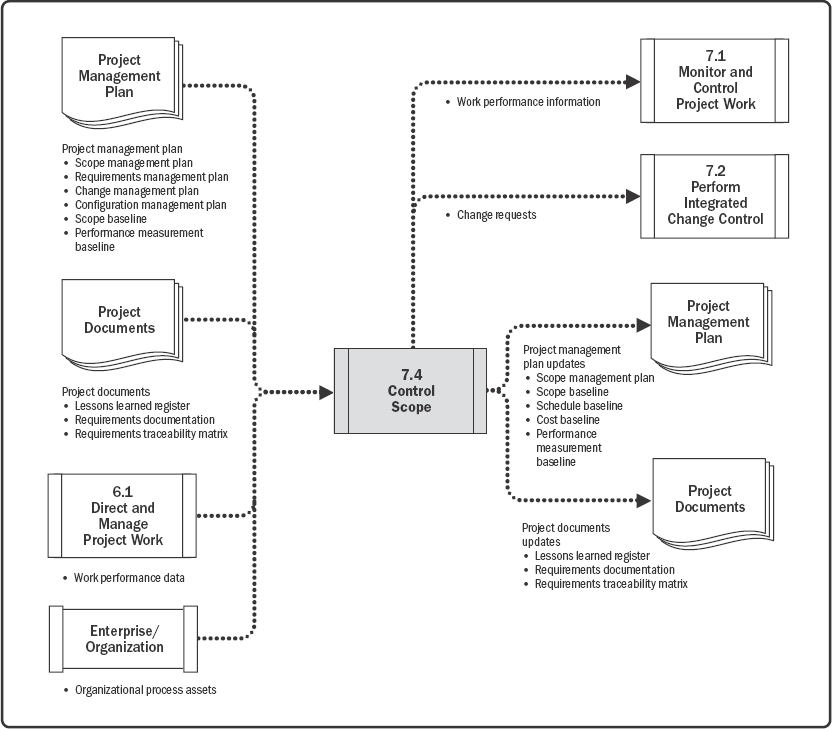
Note: This figure provides the inputs and outputs that may be used for this process. Descriptions for inputs and outputs appear in Section 9.
Figure 7-8. Control Scope: Data Flow Diagram
Controlling the project scope ensures all requested changes and recommended corrective or preventive actions are processed through the Perform Integrated Change Control process (see Section 7.2). Control Scope is also used to manage the actual changes when they occur and is integrated with the other control processes. The uncontrolled expansion to product or project scope without adjustments to time, cost, and resources is referred to as scope creep. Change is inevitable; therefore, some type of change control process is mandatory for every project.
7.5 CONTROL SCHEDULE
Control Schedule is the process of monitoring the status of the project to update the project schedule and managing changes to the schedule baseline. The key benefit of this process is that the schedule baseline is maintained throughout the project.
This process is performed throughout the project. The inputs, tools and techniques, and outputs are shown in Figure 7-9. Figure 7-10 presents the data flow diagram for this process.
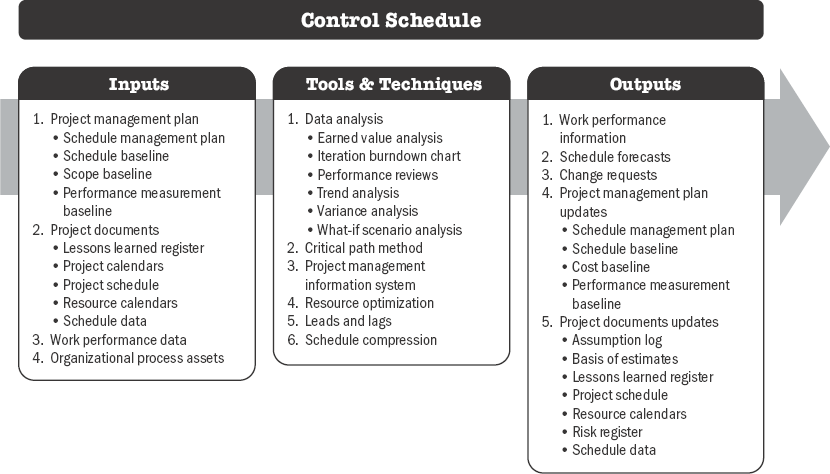
Note: This figure provides the inputs, tools and techniques, and outputs that may be used for this process. Descriptions for inputs and outputs appear in Section 9. Descriptions for tools and techniques appear in Section 10.
Figure 7-9. Control Schedule: Inputs, Tools & Techniques, and Outputs

Note: This figure provides the inputs and outputs that may be used for this process. Descriptions for inputs and outputs appear in Section 9.
Figure 7-10. Control Schedule: Data Flow Diagram
Updating the schedule model requires knowing the actual performance to date. Any change to the schedule baseline can only be approved through the Perform Integrated Change Control process (Section 7.2). Control Schedule, as a component of the Perform Integrated Change Control process, is concerned with:
▶Determining the current status of the project schedule,
▶Influencing the factors that create schedule changes,
▶Reconsidering necessary schedule reserves,
▶Determining if the project schedule has changed, and
▶Managing the actual changes as they occur.
When an agile approach is used, Control Schedule is concerned with:
▶Determining the current status of the project schedule by comparing the total amount of work delivered and accepted against the estimates of work completed for the elapsed time cycle;
▶Conducting retrospectives (scheduled reviews to record lessons learned) for correcting processes and improving, if required;
▶Reprioritizing the remaining work plan (backlog);
▶Determining the rate at which the deliverables are produced, validated, and accepted (velocity) in the given time per iteration (agreed-upon work cycle duration, typically 2 weeks or 1 month);
▶Determining that the project schedule has changed; and
▶Managing the actual changes as they occur.
When work is being contracted, regular and milestone status updates from contractors and suppliers are a means of ensuring the work is progressing as agreed upon to ensure the schedule is under control. Scheduled status reviews and walkthroughs should be done to ensure the contractor reports are accurate and complete.
7.6 CONTROL COSTS
Control Costs is the process of monitoring the status of the project to update the project costs and managing changes to the cost baseline. The key benefit of this process is that the cost baseline is maintained throughout the project.
This process is performed throughout the project. The inputs, tools and techniques, and outputs are shown in Figure 7-11. Figure 7-12 presents the data flow diagram for this process.

Note: This figure provides the inputs, tools and techniques, and outputs that may be used for this process. Descriptions for inputs and outputs appear in Section 9. Descriptions for tools and techniques appear in Section 10.
Figure 7-11. Control Costs: Inputs, Tools & Techniques, and Outputs

Note: This figure provides the inputs and outputs that may be used for this process. Descriptions for inputs and outputs appear in Section 9.
Figure 7-12. Control Costs: Data Flow Diagram
Updating the budget requires knowledge of the actual costs spent to date. Any increase to the authorized budget can only be approved through the Perform Integrated Change Control process (Section 7.2). Monitoring the expenditure of funds without regard to the value of work being accomplished for such expenditures has little value to the project, other than to track the outflow of funds. Much of the effort of cost control involves analyzing the relationship between the consumption of project funds and the work being accomplished for such expenditures. The key to effective cost control is the management of the approved cost baseline.
Project cost control includes:
▶Influencing the factors that create changes to the authorized cost baseline;
▶Ensuring that all change requests are acted on in a timely manner;
▶Managing the actual changes when and as they occur;
▶Ensuring that cost expenditures do not exceed the authorized funding by period, by WBS component, by activity, and in total for the project;
▶Monitoring cost performance to isolate and understand variances from the approved cost baseline;
▶Monitoring work performance against funds expended;
▶Preventing unapproved changes from being included in the reported cost or resource usage;
▶Informing appropriate stakeholders of all approved changes and associated cost; and
▶Bringing expected cost overruns within acceptable limits.
7.7 CONTROL QUALITY
Control Quality is the process of monitoring and recording results of executing the quality management activities in order to assess performance and ensure the project outputs are complete, correct, and meet customer expectations. The key benefit of this process is verifying that project deliverables and work meet the requirements specified by key stakeholders for final acceptance. The Control Quality process determines if the project outputs do what they were intended to do. Those outputs need to comply with all applicable standards, requirements, regulations, and specifications.
This process is performed throughout the project. The inputs, tools and techniques, and outputs are shown in Figure 7-13. Figure 7-14 presents the data flow diagram for this process.
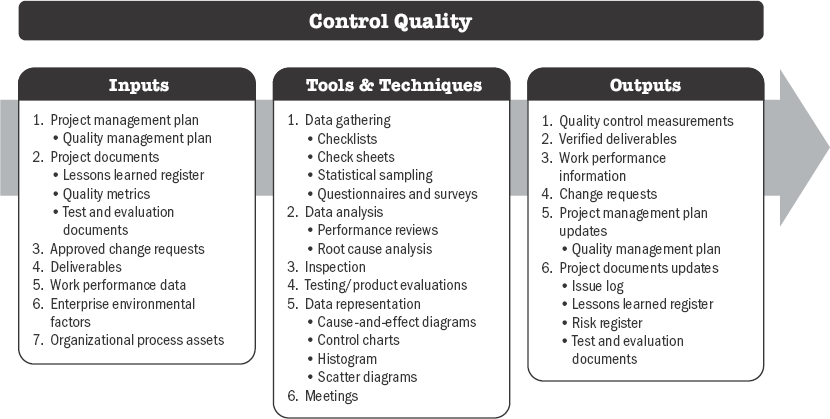
Note: This figure provides the inputs, tools and techniques, and outputs that may be used for this process. Descriptions for inputs and outputs appear in Section 9. Descriptions for tools and techniques appear in Section 10.
Figure 7-13. Control Quality: Inputs, Tools & Techniques, and Outputs

Note: This figure provides the inputs and outputs that may be used for this process. Descriptions for inputs and outputs appear in Section 9.
Figure 7-14. Control Quality: Data Flow Diagram
The Control Quality process is performed to measure the completeness, compliance, and fitness for use of a product or service prior to user acceptance and final delivery. This is done by measuring all steps, attributes, and variables used to verify conformance or compliance to the specifications stated during the planning stage.
Quality control should be performed throughout the project to formally demonstrate, with reliable data, that the sponsor's and/or customer's acceptance criteria have been met.
The level of effort to control quality and the degree of implementation may differ between industries and project management styles. For example, in the pharmaceutical, health, transportation, and nuclear industries, there may be stricter quality control procedures compared to other industries, and the effort needed to meet the standards may be extensive. In agile projects, the Control Quality activities may be performed by all team members throughout the project life cycle. In predictive (waterfall) model-based projects, the quality control activities are performed at specific times toward the end of the project or phase by specified team members.
7.8 CONTROL RESOURCES
Control Resources is the process of ensuring that the physical resources assigned and allocated to the project are available as planned, as well as monitoring the planned versus actual utilization of resources and taking corrective action as necessary. The key benefit of this process is ensuring that the assigned resources are available to the project at the right time and in the right place and are released when no longer needed.
This process is performed throughout the project. The inputs, tools and techniques, and outputs are shown in Figure 7-15. Figure 7-16 presents the data flow diagram for this process.
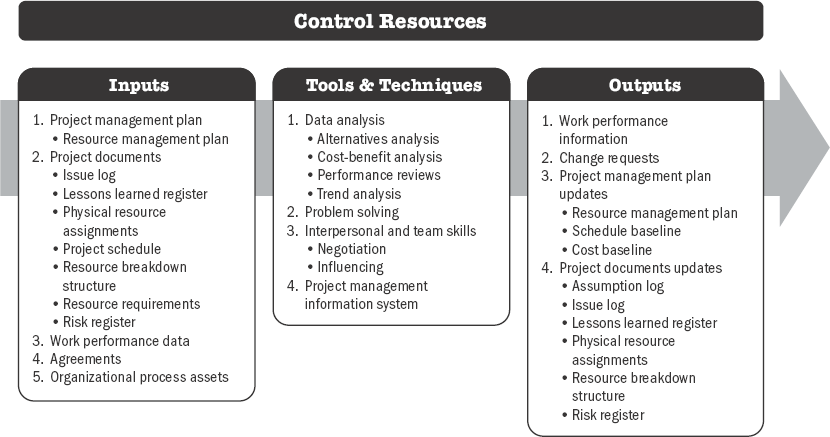
Note: This figure provides the inputs, tools and techniques, and outputs that may be used for this process. Descriptions for inputs and outputs appear in Section 9. Descriptions for tools and techniques appear in Section 10.
Figure 7-15. Control Resources: Inputs, Tools & Techniques, and Outputs

Note: This figure provides the inputs and outputs that may be used for this process. Descriptions for inputs and outputs appear in Section 9.
Figure 7-16. Control Resources: Data Flow Diagram
The Control Resources process should be performed continuously in all project phases and throughout the project life cycle. The resources needed for the project should be assigned and released at the right time, right place, and in the right amount for the project to continue without delays. The Control Resources process is concerned with physical resources such as equipment, materials, facilities, and infrastructure. Team members are addressed in the Manage Team process.
Updating resource allocation requires knowing what actual resources have been used to date and what is still needed. This is done mainly by reviewing the performance usage to date. Control Resources is concerned with:
▶Monitoring resource expenditures,
▶Identifying and dealing with resource shortage/surplus in a timely manner,
▶Ensuring that resources are used and released according to the plan and project needs,
▶Informing appropriate stakeholders if any issues arise with relevant resources,
▶Influencing the factors that can create resource utilization changes, and
▶Managing the actual changes as they occur.
Any changes needed to the schedule or cost baselines can be approved only through the Perform Integrated Change Control process (Section 7.2).
The Control Resources techniques discussed here are those used most frequently on projects. There are many others that may be useful on certain projects or in some application areas.
7.9 MONITOR COMMUNICATIONS
Monitor Communications is the process of ensuring the information needs of the project and its stakeholders are met. The key benefit of this process is the optimal information flow as defined in the communications management plan and the stakeholder engagement plan.
This process is performed throughout the project. The inputs, tools and techniques, and outputs are shown in Figure 7-17. Figure 7-18 presents the data flow diagram for this process.

Note: This figure provides the inputs, tools and techniques, and outputs that may be used for this process. Descriptions for inputs and outputs appear in Section 9. Descriptions for tools and techniques appear in Section 10.
Figure 7-17. Monitor Communications: Inputs, Tools & Techniques, and Outputs

Note: This figure provides the inputs and outputs that may be used for this process. Descriptions for inputs and outputs appear in Section 9.
Figure 7-18. Monitor Communications: Data Flow Diagram
Monitor Communications determines if the planned communications artifacts and activities have had the desired effect of increasing or maintaining stakeholders’ support for the project's deliverables and expected outcomes. The impact and consequences of project communications should be carefully evaluated and monitored to ensure that the right message with the right content (the same meaning for sender and receiver) is delivered to the right audience, through the right channel, and at the right time. Monitor Communications may require a variety of methods, such as customer satisfaction surveys, collecting lessons learned, observations of the team, reviewing data from the issue log, or evaluating changes in the stakeholder engagement assessment matrix (refer to data representation in Section 10, Figure 10-22).
The Monitor Communications process can trigger an iteration of the Plan Communications Management and/or Manage Communications processes to improve the effectiveness of communication through additional and possibly amended communications plans and activities. Such iterations illustrate the continuous nature of the communications management processes. Issues or key performance indicators, risks, or conflicts may trigger an immediate revision.
7.10 MONITOR RISKS
Monitor Risks is the process of monitoring the implementation of agreed-upon risk response plans, tracking identified risks, identifying and analyzing new risks, and evaluating risk process effectiveness throughout the project. The key benefit of this process is that it enables project decisions to be based on current information about overall project risk exposure and individual project risks.
This process is performed throughout the project. The inputs, tools and techniques, and outputs are shown in Figure 7-19. Figure 7-20 presents the data flow diagram for this process.
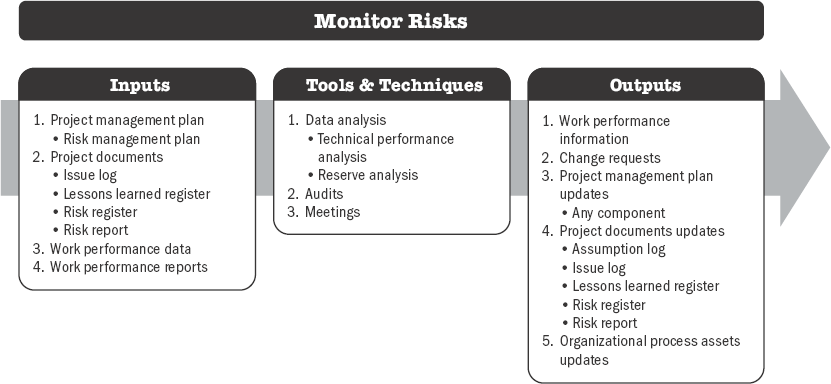
Note: This figure provides the inputs, tools and techniques, and outputs that may be used for this process. Descriptions for inputs and outputs appear in Section 9. Descriptions for tools and techniques appear in Section 10.
Figure 7-19. Monitor Risks: Inputs, Tools & Techniques, and Outputs
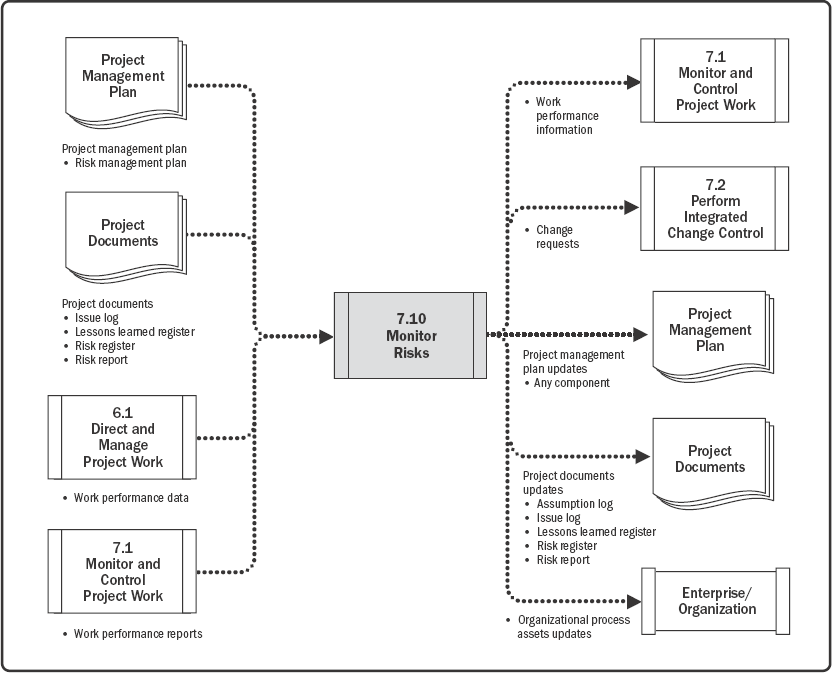
Note: This figure provides the inputs and outputs that may be used for this process. Descriptions for inputs and outputs appear in Section 9.
Figure 7-20. Monitor Risks: Data Flow Diagram
In order to ensure that the project team and key stakeholders are aware of the current level of risk exposure, project work should be continuously monitored for new, changing, and outdated individual project risks and for changes in the level of overall project risk by applying the Monitor Risks process. The Monitor Risks process uses the performance information generated during project execution to determine if:
▶Implemented risk responses are effective,
▶Level of overall project risk has changed,
▶Status of identified individual project risks has changed,
▶New individual project risks have arisen,
▶Risk management approach is still appropriate,
▶Project assumptions are still valid,
▶Risk management policies and procedures are being followed,
▶Contingency reserves for cost or schedule require modification, and
▶Project strategy is still valid.
7.11 CONTROL PROCUREMENTS
Control Procurements is the process of managing procurement relationships, monitoring contract performance and making changes and corrections as appropriate, and closing out contracts. The key benefit of this process is that it ensures that both the seller's and buyer's performance meet the project's requirements according to the terms of the legal agreement.
This process is performed throughout the project as needed. The inputs, tools and techniques, and outputs are shown in Figure 7-21. Figure 7-22 presents the data flow diagram for this process.

Note: This figure provides the inputs, tools and techniques, and outputs that may be used for this process. Descriptions for inputs and outputs appear in Section 9. Descriptions for tools and techniques appear in Section 10.
Figure 7-21. Control Procurements: Inputs, Tools & Techniques, and Outputs

Note: This figure provides the inputs and outputs that may be used for this process. Descriptions for inputs and outputs appear in Section 9.
Figure 7-22. Control Procurements: Data Flow Diagram
Both the buyer and the seller administer the procurement contract for similar purposes. Each is required to ensure that both parties meet their contractual obligations and that their own legal rights are protected. The legal nature of the relationship makes it imperative that the project management team is aware of the implications of actions taken when controlling any procurement. On larger projects with multiple providers, a key aspect of contract administration is managing communication among the various providers.
Because of the legal aspect, many organizations treat contract administration as an organizational function that is separate from the project. While a procurement administrator may be on the project team, this individual typically reports to a supervisor from a different department.
Control Procurements includes application of the appropriate project management processes to the contractual relationship(s) and integration of the outputs from these processes into the overall management of the project. This integration often occurs at multiple levels when there are multiple sellers and multiple products, services, or results involved.
The quality of the controls, including the independence and credibility of procurement audits, is critical to the reliability of the procurement system. The organization's code of ethics, its legal counsel, and external legal advisory arrangements, including any ongoing anti-corruption initiatives, can contribute to proper procurement controls.
Control Procurements has a financial management component that involves monitoring payments to the seller. This ensures that payment terms defined within the contract are met and that compensation is linked to the seller's progress as defined in the contract. A principal concern when making payments is to ensure there is a close relationship of payments made to the work accomplished. A contract that requires payments linked to project outputs and deliverables, rather than inputs such as labor hours, has better controls.
Agreements can be amended at any time prior to contract closure by mutual consent in accordance with the change control terms of the agreement. Such amendments are typically captured in writing.
7.12 MONITOR STAKEHOLDER ENGAGEMENT
Monitor Stakeholder Engagement is the process of monitoring project stakeholder relationships and tailoring strategies for engaging stakeholders through the modification of engagement strategies and plans. The key benefit of this process is that it maintains or increases the efficiency and effectiveness of stakeholder engagement activities as the project evolves and its environment changes.
This process is performed throughout the project. The inputs, tools and techniques, and outputs are shown in Figure 7-23. Figure 7-24 presents the data flow diagram for this process.
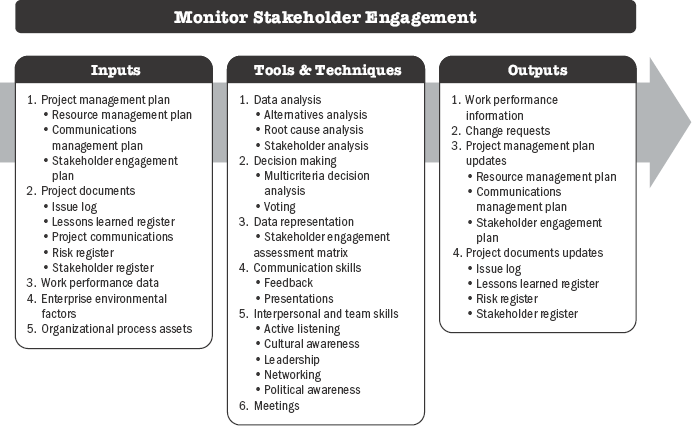
Note: This figure provides the inputs, tools and techniques, and outputs that may be used for this process. Descriptions for inputs and outputs appear in Section 9. Descriptions for tools and techniques appear in Section 10.
Figure 7-23. Monitor Stakeholder Engagement: Inputs, Tools & Techniques, and Outputs
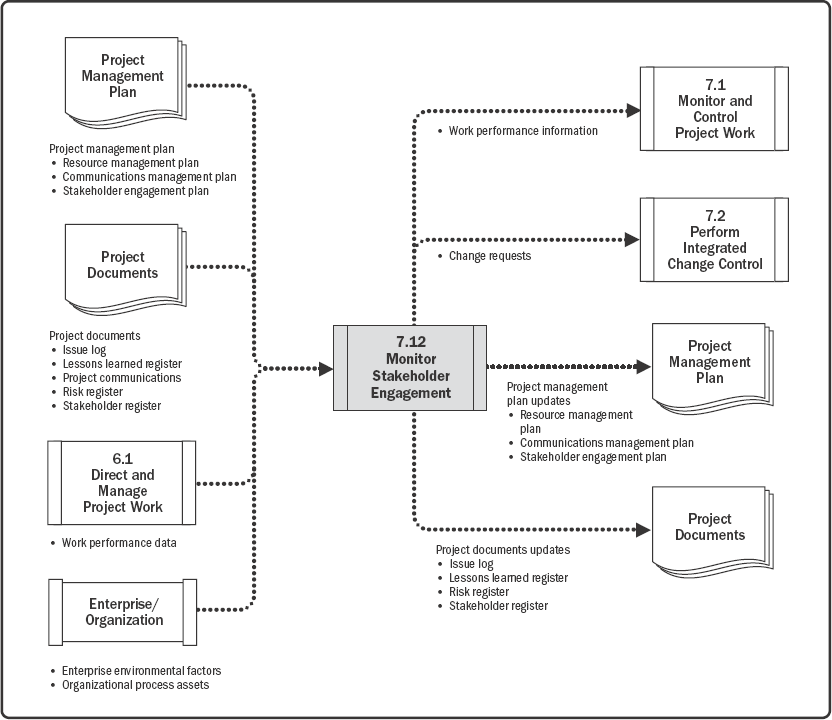
Note: This figure provides the inputs and outputs that may be used for this process. Descriptions for inputs and outputs appear in Section 9.
Figure 7-24. Monitor Stakeholder Engagement: Data Flow Diagram
